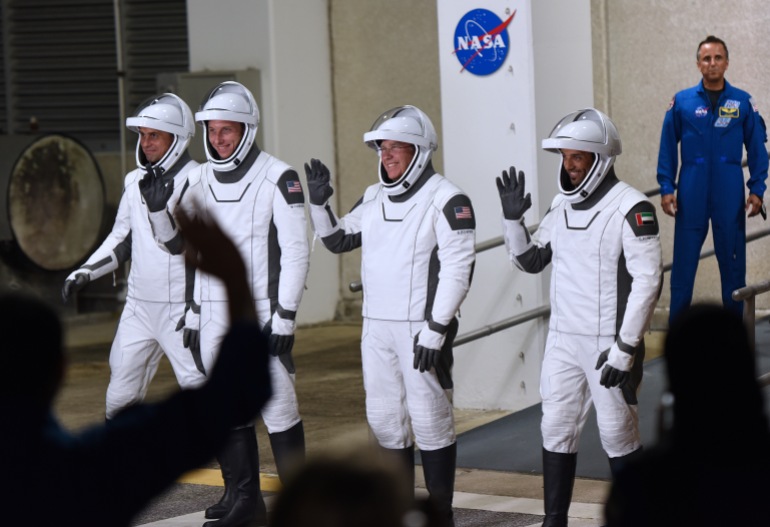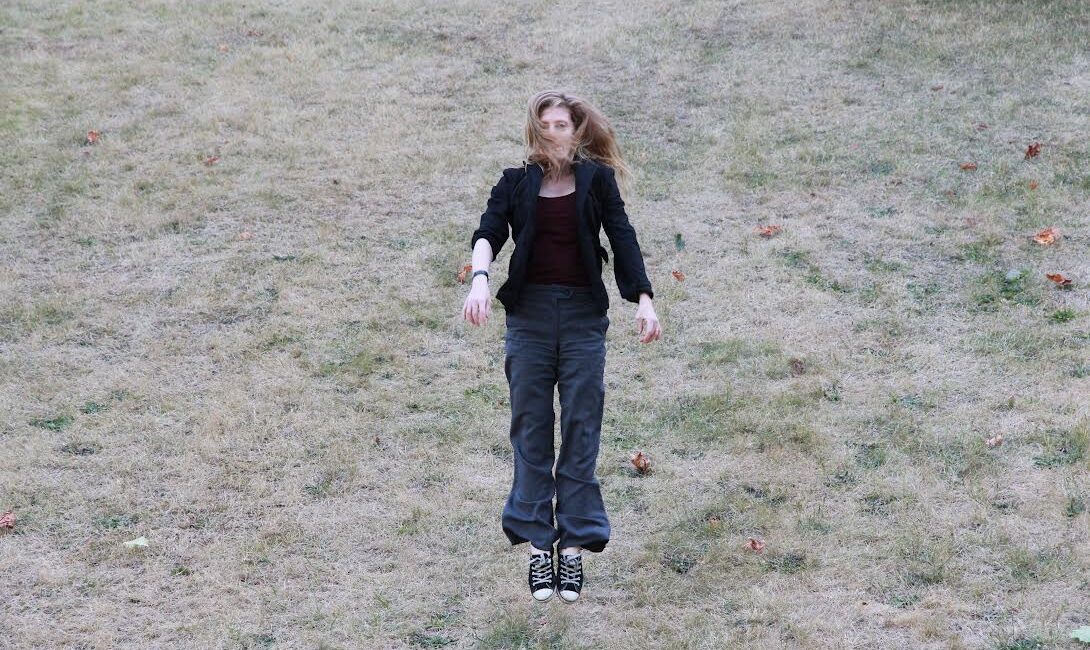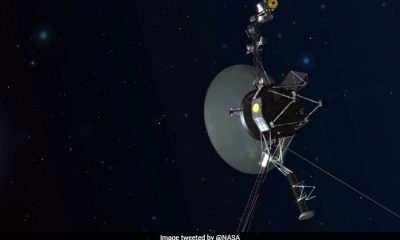Science
SpaceX launches US, Russia, UAE astronauts to space station

|
|
Elon Musk’s rocket company has sent the four astronauts to the International Space Station.
Elon Musk’s rocket company SpaceX has launched four astronauts to the International Space Station for NASA, including the first person from the Arab world to go for an extended monthslong stay.
The Falcon rocket bolted from the Kennedy Space Center in Cape Canaveral, Florida shortly after midnight on Thursday, illuminating the night sky as it headed up the East Coast.
The trip to the International Space Station (ISS), a laboratory orbiting some 420km (250 miles) above Earth, was expected to take nearly 25 hours, with rendezvous planned for about 06:15 GMT on Friday.
Nearly 80 spectators from the United Arab Emirates watched from the launch site as astronaut Sultan al-Neyadi – only the second Emirati to fly to space – blasted off on his six-month mission.
Half a world away in Dubai and elsewhere across the UAE, schools and offices planned to broadcast the launch live.
Also riding the Dragon capsule that is due at the space station on Friday: NASA’s Stephen Bowen, a retired Navy submariner who logged three space shuttle flights, and Warren “Woody” Hoburg, a former research scientist at Massachusetts Institute of Technology and space newbie, and Andrey Fedyaev, a space rookie who has retired from the Russian Air Force.
The first attempt to launch them was called off on Monday at the last minute because of a clogged filter in the engine ignition system.
They will replace a US-Russian-Japanese crew that has been up there since October. The other station residents are two Russians and an American whose six-month stay was doubled, until September, after their Soyuz capsule sprang a leak. A replacement Soyuz arrived last weekend.
Al-Neyadi, a communications engineer, served as a backup for the first Emirati astronaut, Hazza al-Mansoori, who rode a Russian rocket to the space station in 2019 for a weeklong visit. The UAE paid for al-Neyadi’s seat on the SpaceX flight.
The UAE’s minister for public education and advanced technology, Sarah al-Amiri, said the long mission “provides us a new venue for science and scientific discovery for the country”.
“We don’t want to just go to space and then not have much to do there or not have impact,” said the director general of the UAE’s space centre in Dubai, Salem al-Marri.
The UAE already has a spacecraft orbiting Mars, and a mini rover is hitching a ride to the Moon on a Japanese lander. Two new UAE astronauts are training with NASA’s latest astronaut picks in Houston.
Saudi Prince Sultan bin Salman was the first Arab in space, launching on board the shuttle Discovery in 1985. He was followed two years later by Syrian astronaut Muhammed Faris, launched by Russia. Both were in space for about a week.
Al-Neyadi will be joined this spring by two Saudi astronauts going to the space station on a short private SpaceX flight paid for by their government.
“It’s going to be really exciting, really interesting” to have three Arabs in space at once, he said last week. “Our region is also thirsty to learn more.”
He is taking up lots of dates to share with his crewmates, especially during Ramadan, the Muslim holy month which begins this month. As for observing Ramadan in orbit, he said fasting is not compulsory since it could make him weak and jeopardise his mission.
Bowen, the crew’s leader, said the four have jelled well as a team despite differences between their countries. Even with the tension over the war in Ukraine, the US and Russia have continued to work together on the space station and trade seats on rides there.
“It’s just tremendous to have the opportunity to fly with these guys,” Bowen said.





Science
NASA hears from Voyager 1, the most distant spacecraft from Earth, after months of quiet
|
|
CAPE CANAVERAL, Fla. (AP) – NASA has finally heard back from Voyager 1 again in a way that makes sense.
The most distant spacecraft from Earth stopped sending back understandable data last November. Flight controllers traced the blank communication to a bad computer chip and rearranged the spacecraft’s coding to work around the trouble.
NASA’s Jet Propulsion Laboratory in Southern California declared success after receiving good engineering updates late last week. The team is still working to restore transmission of the science data.
It takes 22 1/2 hours to send a signal to Voyager 1, more than 15 billion miles (24 billion kilometers) away in interstellar space. The signal travel time is double that for a round trip.
Contact was never lost, rather it was like making a phone call where you can’t hear the person on the other end, a JPL spokeswoman said Tuesday.
Launched in 1977 to study Jupiter and Saturn, Voyager 1 has been exploring interstellar space – the space between star systems – since 2012. Its twin, Voyager 2, is 12.6 billion miles (20 billion kilometers) away and still working fine.





Science
SpaceX launches 23 Starlink satellites from Florida (photos)


|
|
SpaceX sent yet another batch of its Starlink internet satellites skyward today (April 23).
A Falcon 9 rocket topped with 23 Starlink spacecraft lifted off from Florida’s Cape Canaveral Space Force Station today at 6:17 p.m. EDT (2217 GMT).
The Falcon 9’s first stage came back to Earth for a vertical landing about 8.5 minutes after launch as planned. It touched down on the SpaceX droneship Just Read the Instructions, which was stationed in the Atlantic Ocean.
It was the ninth launch and landing for this particular booster, according to a SpaceX mission description. Five of its previous eight liftoffs were Starlink missions.
The Falcon 9’s upper stage will continue carrying the 23 Starlink satellites toward low Earth orbit (LEO) today, deploying them about 65 minutes after liftoff.
This evening’s launch was the 41st of the year for SpaceX, and the 28th of 2024 dedicated to building out the huge and ever-growing Starlink megaconstellation. There are nearly 5,800 operational Starlink satellites in LEO at the moment, according to astrophysicist and satellite tracker Jonathan McDowell.
The Starlink launch ended up being the first half of a spaceflight doubleheader: A Rocket Lab Electron vehicle launched two satellites, including a NASA solar-sailing technology demonstrator, from New Zealand today at 6:33 p.m. EDT (2233 GMT).
Editor’s note: This story was updated at 6:30 p.m. ET on April 23 with news of successful launch and first-stage landing.





Science
Exploring ecological networks in a digital world | News | Vancouver Island University | Canada – Vancouver Island University News


Getting to know Samantha Letourneau
By day, Samantha Letourneau is Vancouver Island University’s Canada Learning Bond project lead and Volunteer Tutor Coordinator. She’s also a musician and dancer and for the past two years, she’s been collaborating with Swedish artist Mårten Spångberg, thanks to funding obtained through Crimson Coast Dance, to create a digital art installation that goes live on Friday, April 26. A launch event takes place at Black Rabbit restaurant in the Old City Quarter that night. Samantha is also hosting a creative process workshop on April 27 and 28.
Can you share a bit about your background as an artist and how you got into it?
I have been working in art for a very long time, as a musician and dancer as well as an art administrator and program coordinator. I started music at the age of 11 and dance came later in my life in my early 20s. I always wanted to do dance, but I grew up in a small community in Yellowknife and at that time the only dance classes available were highland dancing, which I was not very interested in.
In my early 20s while living in Vancouver, I took classes in contemporary dance and was fortunate to land a small part in the Karen Jameison Dance company for a piece called The River. The River was about rivers and connection between the reality of a real and physical outdoor river and the different reality of “the river within.” It was both a piece of art and outreach for the community. It included working with the S’pak’wus Slu’lum Dancers of the Squamish Nation. Somewhat ground-breaking for 1998.
From there I was hooked and wanted to do more in dance. I studied a lot and took many classes. Fast forward to now, I have been involved with productions and performances with Crimson Coast Dance for more than 15 years and greatly appreciate the talent and innovation that Artistic Director Holly Bright has brought to this community. She is amazing and very supportive of artists in Nanaimo.
How did this international exchange come about?
The Nordic/Nanaimo exchange is one of the innovative projects Holly created. At the height of the pandemic, funded by BC Arts Council and Made In BC, Crimson Coast Dance embarked on a project that explored the ways in which Nanaimo artists could participate in online exchanges.
Two artists in Nanaimo – myself and Genevieve Johnson – were introduced to artists from Europe and supported through this international exchange. My collaborator, Mårten Spångberg, is a Swedish artist living and working in Berlin. An extension of that exchange is funded by Canada Council for the Arts – Digital Now.
What brought Mårten and myself together – and I quote Mårten here – is “questions around climate change, ecology and the influence contemporary society has on its environments. We are not interested in making art about the ecological crises or informing our audience about the urgency that climate change implies, but instead through our research develop work that in itself proposes, practices and engages in alternative ecologies.”
We share an understanding that art is a unique place, in the sense of practice, activation, performance and event, through which alternative ecologies can emerge and be probed and analyzed.
Tell us about the launch event.
We are launching the digital art installation that Mårten and I created on April 26 at The Attic at Black Rabbit Restaurant. The event is free to attend but people must sign up as seating is limited. I produced video art with soundscapes that I recorded mixing field recordings with voice and instrumentation. Marten explores text, imagery and AI.
My focus is on the evolving and ongoing process of how we communicate with each other and to nature within a digital context.
During our collaboration, Mårten and I talked about networks, though not just the expansive digital network of the internet but of nature. We shared thoughts on mycelium, a network of fungal threads or hyphae, that lately has received much attention on the importance of its function for the environment, including human beings.
Building off this concept, ideas of digital and ecological landscapes being connected emerged. From this we worked both collaboratively and individually to produce material for this digital project. Mårten will be there via Zoom as well and we will talk about this two-year process and the work we created together.
-



 Health5 hours ago
Health5 hours agoRemnants of bird flu virus found in pasteurized milk, FDA says
-
Art10 hours ago
Mayor's youth advisory council seeks submissions for art gala – SooToday
-
News16 hours ago
Some Canadians will be digging out of 25+ cm of snow by Friday – The Weather Network
-



 Science18 hours ago
Science18 hours ago"Hi, It's Me": NASA's Voyager 1 Phones Home From 15 Billion Miles Away – NDTV
-
Media16 hours ago
Jon Stewart Slams the Media for Coverage of Trump Trial – The New York Times
-
Art22 hours ago
Made Right Here: Woodworking art – CTV News Kitchener
-



 Investment9 hours ago
Investment9 hours agoTaxes should not wag the tail of the investment dog, but that’s what Trudeau wants
-



 Sports20 hours ago
Sports20 hours agoAuston Matthews turns it up with three-point night as Maple Leafs slay Bruins in Game 2 – Toronto Sun




